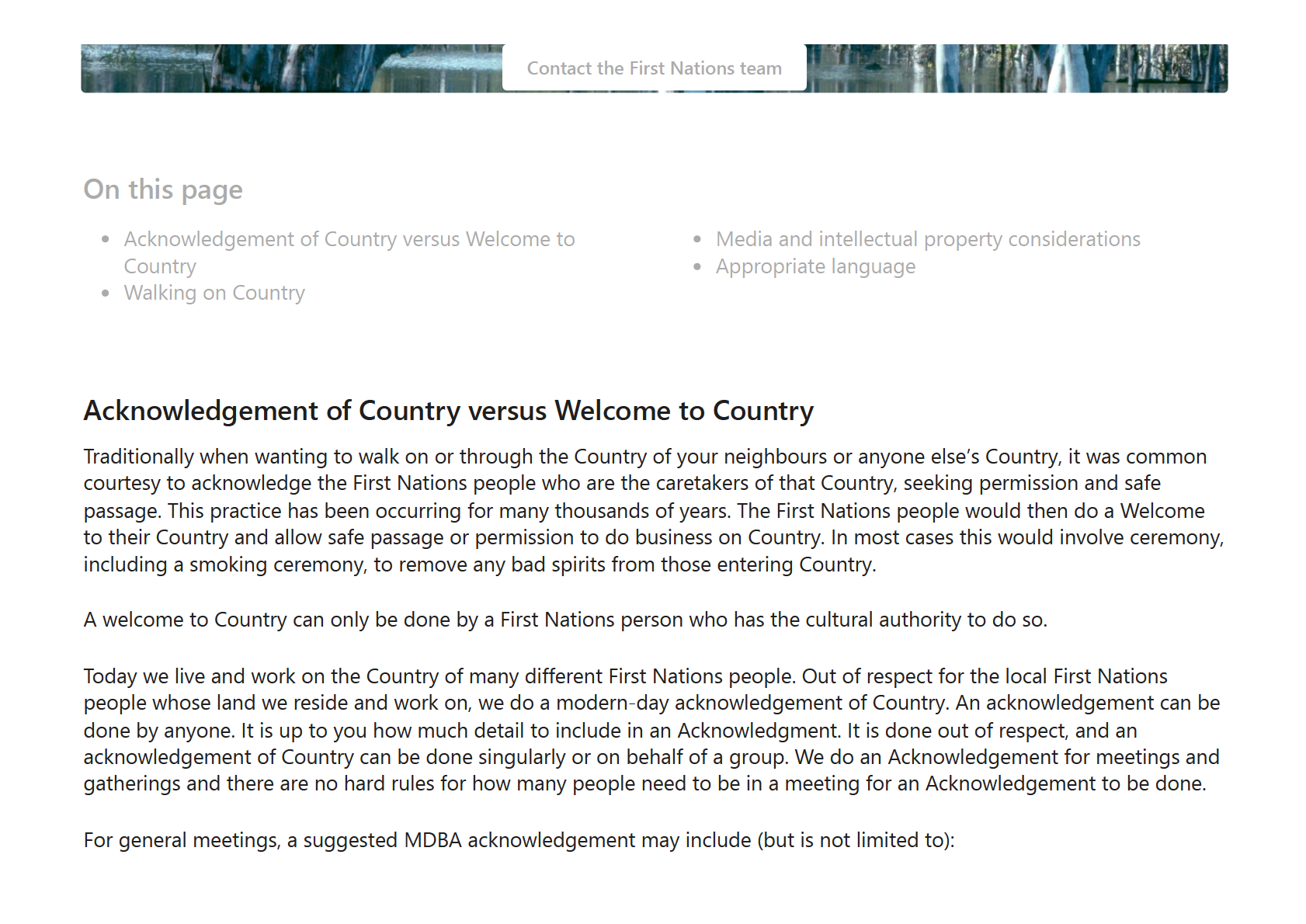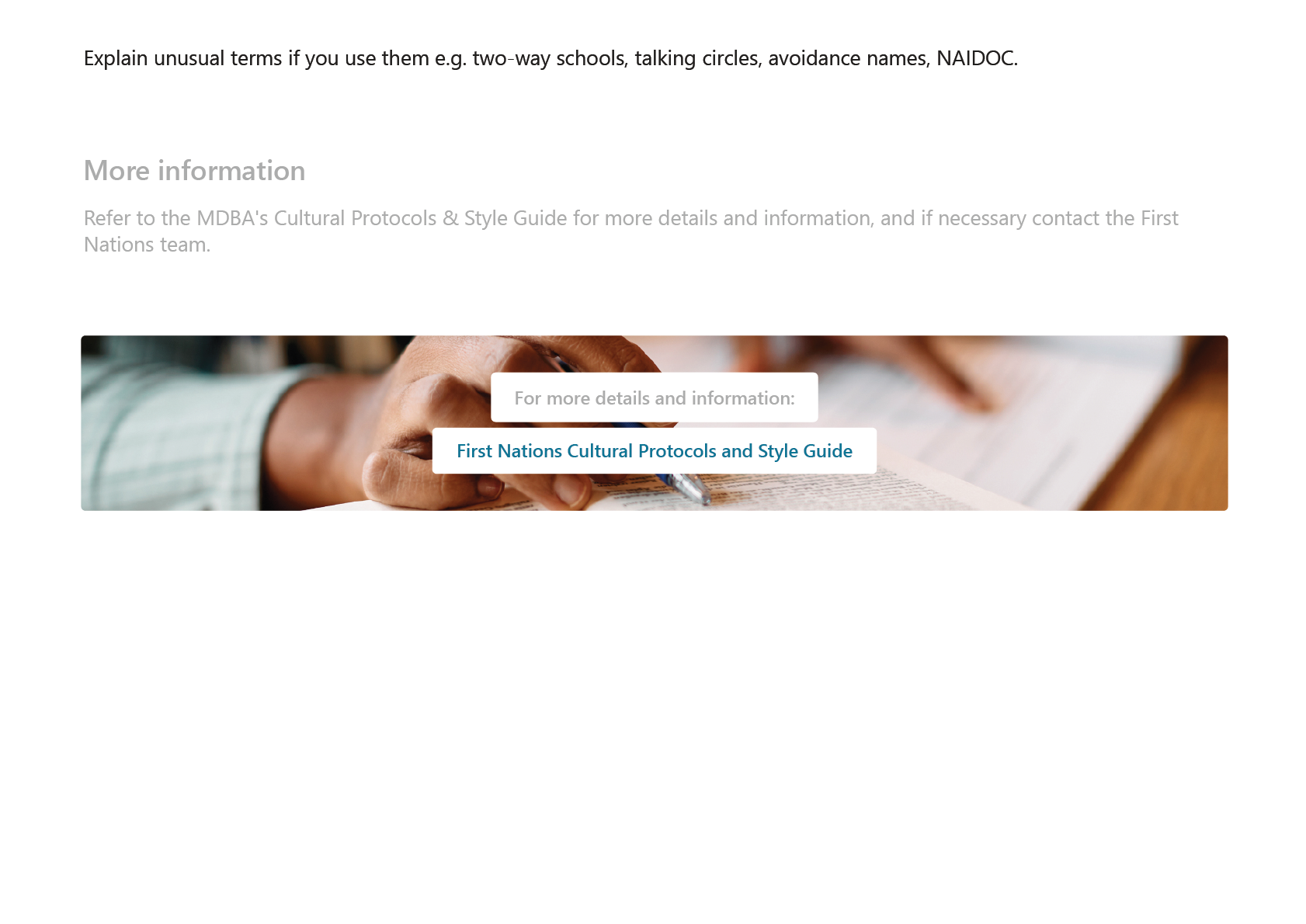

I acknowledge the Traditional Owners of the land/s upon which we meet today the [insert Traditional
Owner Nation name/s]. I offer my respect to their Elders past and present. And I extend that respect to
any Aboriginal or Torres Strait Islander people with us today.
Once you are comfortable with this foundation acknowledgement you may wish to consider tailoring it to your location,
what the significance or importance of the Country you are on, recognising the Aboriginal and Torres Strait Islander peoples
deep ongoing connection to land, water, culture, community and Country.
For further information regarding acknowledgements for emails, publications, access cards and PowerPoint please consult
the MDBA First Nations Cultural Protocols and Style Guide.
Walking on Country
When a First Nation person invites you to walk with them on their Country, it can be a sign of respect, the equivalent of
being asked into a family home.
What is meant by walking on Country?
“For many First Nations people, ‘Country’ encapsulates more than just the physical aspects of the
environment like creeks, rock outcrops, hills, rivers and waterholes. Country includes all living and non-
living. It incorporates people, spirits, plants and animals. It embraces the seasons, stories and creation
spirits and First Nation world view where every organism has an equally important role to play.
Country is both a place of belonging, self-identity, a way of believing, and a way of living”
From Our Country. ©2020 Aboriginal Art & Culture, Alice Springs.
Walking on Country means walking on ground that has cultural and spiritual significance for First Nations people. You should
seek prior permission before walking on Country. For example, when planning to undertake engagement on Country with a
First Nations community, you should phone ahead and speak to an appropriate community member. You could contact the
local Aboriginal Lands Council or other Aboriginal corporation and seek prior permission to undertake engagement and
enter Country. If you wish to look at a place of cultural significance, you should also seek prior permission. You may need to
be guided while on Country and, in some instances, you may need to go through a smoking ceremony before entering
Country. You should be aware that after asking, you may be denied permission to walk on Country as there may be
important cultural reasons for denying you permission, such as special Men’s or Women’s business sites.
A famous example of a sacred Women’s Business site is a large area of Uluru that is permanently closed to tourists. Women’s
business (including childbirth) occurs in this place and only First Nations women who live in this area are permitted on the
site. You should always be mindful of the fact that regardless of the response, asking for permission is respectful.
Media and Intellectual property considerations
Recognising culturally sensitive information
From time to time while working with the Basin’s First Nations people, you may find yourself hearing culturally sensitive
information. If you feel that what you have been shown or told is culturally sensitive information, tell the person that you feel
it may be culturally sensitive information and ask them, “is this something you would share with other Australians or
foreigners?” If they would not share it, then it is culturally sensitive. Let them know you are happy to record the information
and return it to them, but you won’t be writing it down for others to see and use.
A fictional example of culturally sensitive information can be found in the MDBA First Nations cultural protocols and style
guide. See Guidance Note: Handling of culturally sensitive information.
Publishing stories and ideas
The use of traditional stories in publications should be discussed with the custodians of the stories before publication,
especially if the traditional story is being published for the first time. There may be more than one group that has
custodianship of a story.
Once publicly released, it is difficult to control how a story might be re-used. There are also legal limits in being able to
control the general expression of First Nations stories and knowledge once the copyright period expires.
Images
One of the main cultural considerations for publishing images is that some First Nations people do not like to see images, or
the names, of people who have passed away. Others don’t mind. The safest approach is to avoid potential offence by not
publishing images of people who have passed away.
If there is doubt, for instance if you are using an old image from the image gallery you should provide a warning in the front
of the publication. For example, in the MDBA annual report we say: ‘This report may contain photographs or quotes by
Aboriginal people who have passed away.’
There are also some situations where the family or community may give permission to use the image and name of someone
who has passed away. But this would only be on a case by case basis and in discussion with the Aboriginal Partnerships
team.
Some images may depict a sacred site of Men’s or Women’s Business, in which case the image should not be seen by the
opposite gender. When using landscape images please ensure you know where the image is from and if there are any
cultural sensitivities attached.
Permission should always be sought before any image of a First Nations person is used. If you are sourcing new images,
please discuss this with the Aboriginal Partnerships team to make sure we are not contacting the same person or community
several times.
There is a First Nations specific Agreement to use creative content form that should be downloaded and used when
obtaining new photo and/or media material and an information sheet for further guidance.
The above advice is in addition to all relevant MDBA processes and procedures including compliance with the Copyright Act
1968 (Cth) and Privacy Act 1988 (Cth). More information can be found within the MDBA First Nations cultural protocols and
style guide.
Appropriate language
Aboriginal vs Indigenous vs First Nations, Traditional Owner and Traditional Custodian
The term First Nations started in North America and is becoming more widely adopted by Indigenous peoples across the
world. Some of the Basin’s Traditional Owners are electing to be referred to as First Nations, while others prefer to be
referred to as Aboriginal or Traditional Owners. Each situation will be different, the best way to gauge how Traditional
Owners wish to be referred to is to ask before your meeting. This will allow you time to amend PowerPoint presentations
and/or any reference material.
Indigenous is a term given to Australia’s Aboriginal and Torres Strait Islander peoples by modern Australians. The
definition of indigenous is originating or occurring naturally in a particular place; native.
Aboriginal is an English term to describe the original inhabitants of a place, broken down Ab (of) and original (first).
First Nations is the term chosen by some of Australia’s first people.
Traditional Owner is a First Nations person that is recognised by their community.
Traditional Custodian signifies that First Nations people are part of their Country and their role is not one of ownership
but of custodianship, looking after Country to benefit all living entities.
Terms to avoid
The National Museum of Australia (2007), Amnesty International (2011), and the Indigenous Communications and
Engagement Support section of the Department of the Prime Minister and Cabinet (2015) suggest avoiding the following
words:
Aborigine.
Aboriginal (by itself)
. You need to say
Aboriginal person/people.
Koori, Murri, Noongar. Although these terms are used by First Nations people to identify themselves, it can be
considered insensitive if used by non-First Nations people unless you are well known within the community.
ATSI or other similar acronyms. Always spell out the words.
black, white.
blackfella. First Nations people may refer to themselves as blackfellas, but this term can offend if not used carefully.
dialect. This can suggest that it is not a real language.
Dreamtime. Use
Dreaming instead or use the appropriate word if known e.g. Tjukurpa, Ungud, Wongar.
Dreamtime
implies something that happened in the past or is just a story.
Dreaming is more complex and incorporates lore, religion,
stories and relationships ('Dreamtime' and 'The Dreaming' Christine Nicholls 2014).
f
ull-blood, half-caste, quarter cast or
native
walkabout
tribe and
tribal. Use
Nation,
clan, group instead
discovered, as it can create a false impression.
It is also important to be careful with tense. If you refer to people only in the past tense, or only use images of ancient sites,
you can make it seem like First Nations people no longer exist or do not have an active role in managing their land today.
The National Museum of Australia recommends using the word ‘
colonise’ when referring in the broad sense to Europeans’
arrival in Australia, rather than ‘
settled’.



